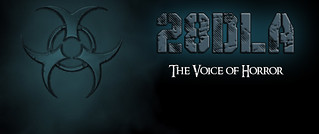
*full disclosure: an online screener of this film was provided by Radius TWC.
Director: Jonas Alexander Arnby.
Writers: Rasmus Birch, Christoffer Boe, Jonas Alexander Arnby.
Cast: Sonia Suhl, Lars Mikkelsen, Sonya Richter.
When Animals Dream is the first feature-length film from Danish director, Jonas Alexander Arnby. This artsy body horror/drama premiered at the Cannes Film Festival in 2014, receiving well-deserved critical acclaim. In the film, sixteen-year-old Marie struggles to form an identity in a small coastal town. To make matters worse, she discovers that she's not like other females, or other humans. Although female coming of age stories are fairly common in horror movies (2000's Ginger Snaps being one of the better ones), there is something unique about this picture. Something subtle. Without copious amounts of violence and gore, this picture slowly tightens its grip, pulling the viewer in. This is not a start to finish action-packed edge of your seat film, but the setting and characters help create a cinematic experience that will prove rewarding if you persevere through the slow burn of the first half.

Sonia Suhl as the tormented Marie.
The film follows Marie, a teenage girl living in a small Danish fishing village with her sick mother and overprotective father. Small-town mentality runs rampant with the locals who seem both afraid and infatuated with mother and daughter alike. Marie receives a lot of attention from men, particularly from her coworkers at the local fish plant. Most of the men in the film, including her father, are not comfortable with Marie and wish to render her powerless. While her father's actions are based on fearing for her safety, the male coworkers seem intent on making her feel uncomfortable and afraid by sexually harassing and attacking her. The fact that she's a strong female makes them feel uneasy, but there's more to this facet of the story than misogyny alone.Marie is going through changes, and not just your typical physical and hormonal changes. Rashes and tufts of hair begin appearing on her body and we quickly learn that her symptoms are likened to what her mother has gone through. The similarities between the two don't stop there. Marie, like her mother, begins experiencing fits of rage and violent tendencies, with vivid disturbing dreams. Her father, along with her family doctor, try to force Marie to take medication to control her urges, like her mother, but Marie refuses with the fierce spirit of a caged animal. Soon it becomes apparent why Marie possesses animal-like qualities; she is in fact part animal. A werewolf. Throughout the film, this young pup struggles with her identity as both female and animal, and learns some hard lessons about trust, loyalty and the price of freedom.
This film tackles some heavy thematic content, most explicitly, the issue of gender and sexuality. The characters, including Marie, are apprehensive about femininity and sexuality. Marie grapples with her body's transformations and the overpowering urges she's experiencing. It seems that, for her, becoming a sexual being coincides with being a predator, and she is becoming both. At one point, she turns to her crush and says, “I'm turning into a monster. I have to have so much sex before that happens. Is that something you can help me with?” This scene is pivotal in Marie's character arc as we start to see her emerge confident, far from what her mother's become (drugged up, stuck at home, and void of freewill).
 Marie's transformation is executed in a subtle yet effective manner, much like the rest of the film. Arnby manages to craft a stylish, sophisticated horror feature without relying heavily on gore or special effects. While there is some gore present, it's not where you expect it. This kind of storytelling won't please all fans of the genre; if you're looking for an all out bloodbath that requires little use of your imagination, this is not for you. There is nothing gratuitous here—everything has its place, and the editing team deserves praise for that. The cinematography is also spot on; the tone is perfectly set in the opening shots by contrasting the freedom of the ocean currents with the confines of the village, particularly the family home. The menacing clouds allude to a danger that looms within the beauty of the coast, and the yellow lights in the family home resemble Marie's yellow eyes during her transformation. This signifies the fact that Marie cannot remain captive for long—she needs to get out.
Marie's transformation is executed in a subtle yet effective manner, much like the rest of the film. Arnby manages to craft a stylish, sophisticated horror feature without relying heavily on gore or special effects. While there is some gore present, it's not where you expect it. This kind of storytelling won't please all fans of the genre; if you're looking for an all out bloodbath that requires little use of your imagination, this is not for you. There is nothing gratuitous here—everything has its place, and the editing team deserves praise for that. The cinematography is also spot on; the tone is perfectly set in the opening shots by contrasting the freedom of the ocean currents with the confines of the village, particularly the family home. The menacing clouds allude to a danger that looms within the beauty of the coast, and the yellow lights in the family home resemble Marie's yellow eyes during her transformation. This signifies the fact that Marie cannot remain captive for long—she needs to get out. This story is character-driven and demands strong performances. Thankfully, the actors deliver. Newcomer Sonia Suhl is particularly impressive as Marie. Her look is similar to Leelee Sobiesky (Walk All Over Me) and her acting is on par. Lars Mikkelsen (Headhunters) and Sonya Richter (The Homesman) give stellar performances as Marie's parents. The chemistry between these three actors is remarkable. Even in the more subdued scenes, the performances are so convincing that you cannot bring yourself to look away. The scenes between father and daughter, showcasing their tumultuous relationship, are particularly heart-wrenching. You truly feel for these characters and want them to be okay.
When Animals Dream is a fascinating coming-of-age tale about a teenage girl struggling to accept what she is becoming—a woman, but also a werewolf. While categorized as a horror film, this feature is far more artsy than gory, and will not appeal to every dread head. That said, if you're looking for something different—something eerie and intelligent, then this film might just be for you. With its effective dark atmosphere and phenomenal acting, this horror fan was impressed.
Rating: 8/10.
Kenna's Blog/Website is available here:
Hey Kenna Rae!
Kenna's Twitter page is below:
Hey Kenna Rae on Twitter
Recommended release: Cub on Blu-ray at Amazon
Subscribe to 28 Days Later: An Analysis 28 Days Later Analysis Email Subscription


 Sunday, August 23, 2015
Sunday, August 23, 2015
 Kenna Rae
Kenna Rae


 Posted in:
Posted in: 


0 comments:
Post a Comment